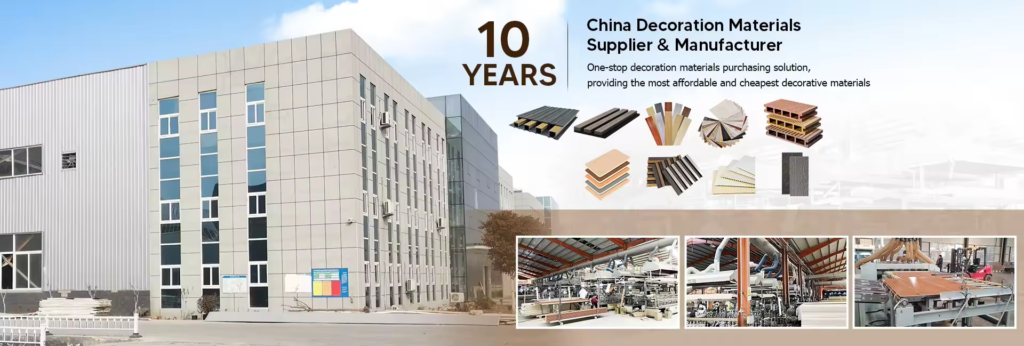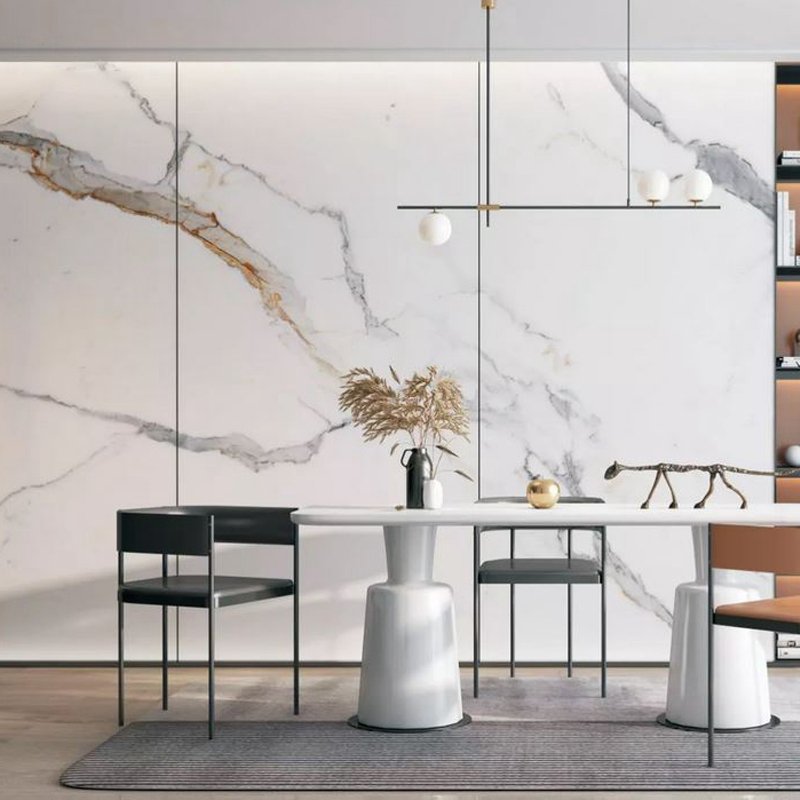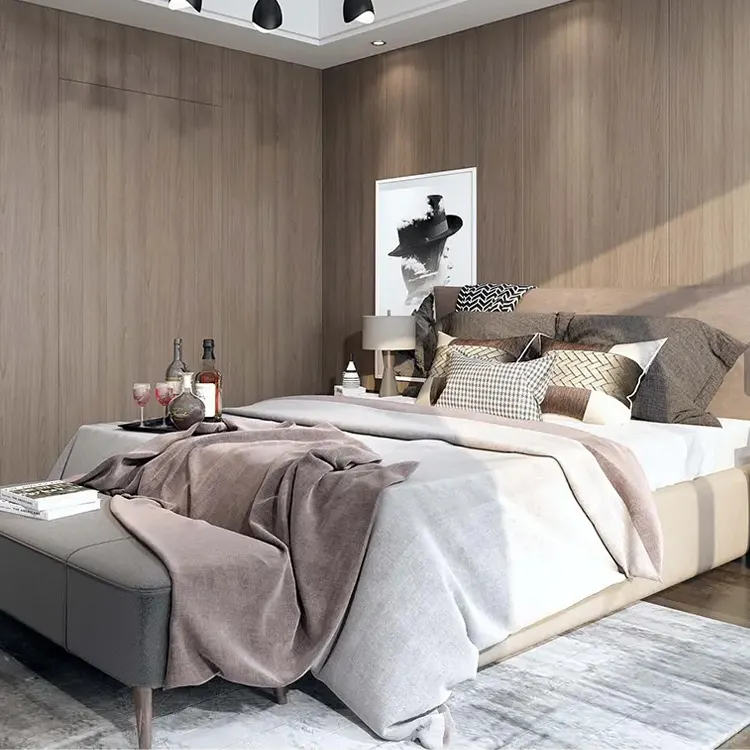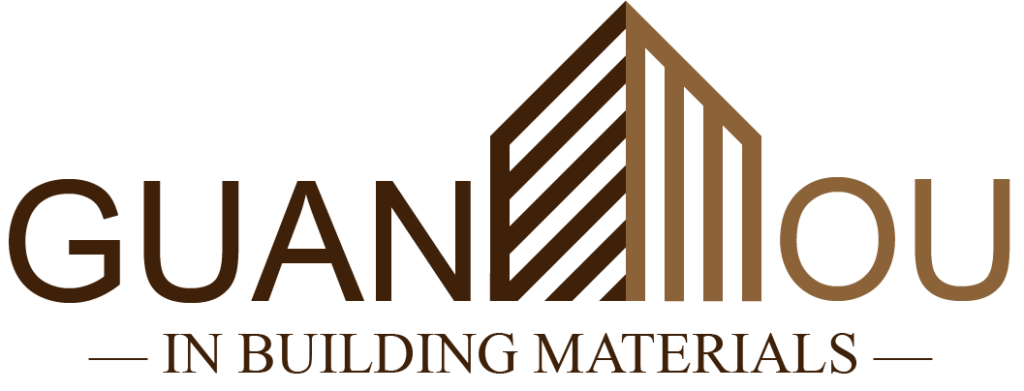
In modern home design, wood veneer panels, with their natural and warm texture, rich grain and color options, as well as excellent plasticity, have become important elements in creating a spatial atmosphere and enhancing the style. The following is an application guide for wood veneer panels in modern homes provided by Guanou New Materials to help you better utilize and unlock more knowledge related to wood veneer:
I.The core charm of wood veneer panels and the convergence point with modern style
- Nature and Warmth: In modern styles such as modern minimalist, industrial, and Nordic, which emphasize lines and cool tones, the natural grain and warmth of wood can effectively neutralize the coldness, creating a comfortable and warm home atmosphere.
- Texture Enhancement: Whether it’s matte, semi-matte or high-gloss surfaces, wood veneer panels can add rich visual and tactile layers to the space, enhancing the overall texture.
- Spatial extension and Unity: The extensive use of wood veneer panels (such as entire walls and ceilings) can visually extend the sense of space, unify the spatial tone, and create an overall sense.
- Design flexibility: Wood veneer panels can be cut and bent (for some types), suitable for various parts such as walls, ceilings, cabinets, door panels, columns, and beams, achieving design coherence and unity.
- Environmental protection and sustainability: Compared with large solid wood boards, decorative panels (especially engineered wood, HPL, etc.) can make more efficient use of wood resources. Choosing FSC-certified products is more environmentally friendly.
II. Key Application Scenarios and Techniques of Wood Veneer Panels in Modern Homes

- Wall surface – the shaper of the spatial tone
Full-wall application: This is the most classic and effective way. Choose a TV background wall, a sofa background wall or a headboard background wall, and cover it with wood veneer panels. It can instantly become the focus of the space and set a warm and stable tone. Modern style prefers simple textures (straight grain, fine grain) and neutral tones (oak, walnut, light gray wood color).
Local embellishments/designs: Use wood veneer panels in certain parts of the wall, such as half-wall designs (wall skirts), geometric cut shapes, and pair them with paint/stone/metal to create material contrasts and enhance the design sense.
Invisible door/storage cabinet door: Covering the door or storage cabinet door with the same wood veneer panel as the wall to achieve an “invisible” effect, maintaining the integrity of the wall and the simplicity of the space. This is a common technique in modern minimalist design.
Splicing methods: In addition to the traditional straight splicing, you can also try more designed splicing methods such as herringbone splicing, fishbone splicing, and mixed splicing (the size of the panel and the loss need to be considered). - Ceiling – Creating a unique atmosphere
Partial ceiling/shaped ceiling: Use wood veneer panels in the partial ceiling areas of the living room, dining room, corridor or bedroom (such as flat ceilings, sloping ceilings, domes) to reduce the sense of height oppression and create a warm, private or unique spatial atmosphere.
Wooden beam effect: Wrap the ceiling false beams or structural beams with wood veneer panels to enhance the naturalness and structural beauty of the space.
Line guidance: Using wood veneer panel strips on the ceiling can serve as visual guidance and for area division. - Cabinets and Furniture – Unity and Texture
Customized cabinet door panels: The door panels of customized cabinets such as kitchen cabinets, wardrobes, bookcases, and TV cabinets are the main areas where wood veneer panels are applied. It can ensure a high degree of unity between the appearance of the cabinet and the overall space style, enhancing the sense of quality. Matte or semi-matte surfaces appear more high-end and modern.
Furniture finishes: Used for customizing or modifying desktops, cabinet sides, drawer panels, etc., to integrate furniture with the space design.
The side of the bar counter/island: The side of the island counter or bar counter in the kitchen is wrapped with wood veneer panels to add a sense of warmth and contrast with the stone countertop. - Columns and beams integrate the structure into decoration
In modern Spaces, if the load-bearing columns or beams are in prominent positions, they can be wrapped and decorated with wood veneer panels to weaken their abruptness and transform them into decorative elements or functional components in the space (such as in combination with lighting and shelves). - Transition and Details – Enhance Refinement
Door and window casings: Use wood veneer panels of the same style as the wall or cabinet to make door and window casings, so that the details are in harmony with the overall look.
Skirting board: Choose skirting boards of the same color or material as the wood veneer panel to enhance the overall sense of unity.
Edge finishing/pressing strips: At the junctions of different materials (such as wood veneer panels and stone, metal, glass), exquisite stainless steel, aluminum alloy or wood-colored edge finishing strips are used to ensure perfect details.
III. Key Considerations for Choosing Wood Veneer Panels (From a Modern Style Perspective
Material type:
Solid wood veneer: The most natural and genuine, with unique texture and the best feel. It is relatively expensive, but attention should be paid to deformation caused by changes in temperature and humidity.
Technological wood veneer: With controllable texture, rich colors, stable performance (not prone to deformation or cracking), high cost performance, and good environmental friendliness, it is the mainstream choice for modern home decoration.
Fireproof board (HPL) : Wear-resistant, scratch-resistant, heat-resistant, easy to clean, with a wide range of color and texture options. It is highly suitable for areas that require durability, such as kitchen cabinets, bars, and dry areas in bathrooms.
New finishes such as CPL/SPC: They have better weather resistance, impact resistance, etc., and are applicable in a wider range of scenarios.
Suggestion: In modern homes, technological wood veneer has become the top choice due to its stability, diversity and cost-effectiveness. HPL is an ideal choice for wet areas such as kitchens and bathrooms, as well as high-usage areas. For those with a sufficient budget and a pursuit of the ultimate natural feel, high-end solid wood veneer is a good choice.
Color and Texture
Tone: Modern style prefers neutral color schemes: Light colors (such as white oak, light grey wood, and beige wood grain) can expand the sense of space and create a bright and fresh atmosphere. Medium and dark tones (such as walnut, deep oak, and smoked wood tones) create a sense of stability, sophistication, and warmth. The grey tones (such as cement grey wood grain) have a strong modern industrial feel. Avoid overly bright or old-fashioned redwood or dark yellow colors.
Texture: Simple, delicate and smooth textures are more in line with modern aesthetics. Straight grain, fine mountain grain, abstract texture or nearly non-textured plain panels are all good choices. Avoid overly rough, exaggerated or antique and aged textures.
Surface treatment: Matte or semi-matte surfaces can better reflect the natural texture and high-end feel of wood, and are also more durable and dirt-resistant. High-gloss surfaces should be used with caution as they may appear cheap and reflect too much light.
Base materials and Environmental protection:
Common base materials: multi-layer board, blockboard (blockboard), particleboard (particle board), medium density fiberboard (MDF). MDF has the highest flatness and is the first choice for decorative surface modeling. The multi-layer board/blockboard has a stable structure and good nail-holding capacity. High-quality particleboard offers good value for money and only needs to meet environmental protection standards.
Environmental protection grade: Must pay attention! Choose products that meet the national E1 level or more stringent standards (such as E0 level, Japanese F4 star, and American CARB certification). Check the authoritative test report. Environmental protection is the bottom line of a healthy home.

IV. Precautions in Design and Application
Overall coordination: The selection of wood veneer panels must serve the overall design style and color scheme. Consider the matching with the floor, furniture, curtains and soft furnishings to avoid conflicts.
Proportion and scale: The extensive use of dark wood veneer panels will make the space appear smaller. Light colors should be used more often in small Spaces. Pay attention to the influence of the wood grain direction on the sense of space (appearing taller vertically and wider horizontally).
Lighting design: Lighting is the soul of wood veneer panels. Key lighting (spotlights, wall-washing lights) can highlight its texture and feel. Ambient light provides basic lighting; Ambient light (light strips) can outline Outlines or create layers. Avoid rigidity caused by a single light source.
Material contrast: Modern style emphasizes the collision of materials. Wood veneer panels, when combined with stone, metal (stainless steel, brass), glass, cement paint, artistic coatings, leather, etc., can create rich visual layers and a modern feel.
Professional installation: The installation of wood veneer panels (especially for large walls) has extremely high requirements for flatness and edge finishing. It is essential to find an experienced professional construction team to ensure that the base treatment is in place, the installation is firm, the joints are smooth and the finishing is exquisite. “Three parts product, seven parts installation!”
Finishing treatment: The finishing at the junctions of different materials, corners, and connections with the ceiling/floor is of vital importance. The use of appropriate edge trims, inserts or process seams directly affects the aesthetic appeal and durability of the final effect.
Maintenance and care: Wipe with a slightly damp soft cloth on a daily basis. Avoid excessive water immersion. Regularly use a dedicated wood cleaner/maintenance agent (choose according to the surface treatment). Avoid scratching with hard objects and placing high-temperature objects directly. Pay attention to controlling the indoor humidity (40%-60% is appropriate).
V. Trends in Modern Home Applications
Mixed and matched splicing: Creative splicing of decorative panels of different colors, textures, and even different materials (wood + stone/metal).
Arc-shaped application: Use flexible decorative panels (such as thin HPL, some engineered wood) to create arc-shaped walls, ceilings, and cabinet corners, softening the spatial lines.
Extra-large-sized panels: Reduce seams and pursue a more integrated and minimalist visual effect.
Wood veneer with imitation concrete/micro-cement texture: blending industrial style with modern feel.
Special treatments such as dyeing and smoking: pursuing unique and individual colors.
Summary:
In modern homes, wood veneer panels serve as a bridge connecting nature and modernity, warmth and simplicity. The key to successful application lies in:
Clarify style positioning: Select colors, textures and surface treatments that conform to modern aesthetics.
Precise scene selection: Focus on key areas such as the background wall, cabinets, and ceiling.
Pay attention to material matching: Make good use of the collision with other modern materials (stone, metal, glass).
Strictly control quality and environmental protection: Choose stable and environmentally friendly mainstream products such as engineered wood or HPL.
Pursuing exquisite craftsmanship: Professional installation and perfect finishing are the guarantees of the effect.
Through meticulous design and application, wood veneer panels can create an ideal home space for you that is both full of natural charm and modern style.



